





First aid at bleedings
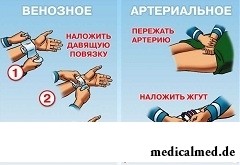 As the injury, and respectively, bleeding owing to it, can happen anywhere and when necessary, each adult has to know how to give first aid at bleedings.
As the injury, and respectively, bleeding owing to it, can happen anywhere and when necessary, each adult has to know how to give first aid at bleedings.
Types of bleedings and their feature
Depending on a type of the injured vessel, distinguish the following types of bleedings:
- Arterial;
- Venous;
- Capillary.
Also bleedings are distinguished in the location. Hands are most often injured – bleedings of upper extremities it is the most widespread look. On the second place of a leg injury, on the third - nasal bleedings. The most dangerous look are bleedings of internals as it is difficult to notice them in time, to keep a situation under control even more difficult. Below we will consider the principles of first-aid treatment at arterial, venous, nasal and internal bleeding.
First aid at arterial and venous bleeding
Many vaguely remember that first aid at arterial bleeding consists in an applying a tourniquet on a vessel, but very few people know how it is correct to make it. Physicians warn: the applying a tourniquet can be not less dangerous, than the loss of blood, ineptly imposed plait can result in need of amputation of an extremity, and alas, quite often brings. How to give first aid at arterial bleeding, without having done harm? You remember, at an injury of a large artery of time in a stock it is a little, only 3-5 minutes. Algorithm of actions following:
- Not to wash out and any in any other manner not to try to disinfect a wound, not to delete the small splinters which got there;
- To apply a compressing bandage as follows: directly to impose the sterile bandage or pure fabric put in several layers on a wound (it is desirable that the dressing material was sterile if that near at hand was not, use any). To atop impose one more roller made of fabric. Then hardly to bandage everything then an extremity it is necessary to arrange higher than the level of a body. If everything is made correctly, bleeding has to stop;
- If near at hand there was nothing that could serve as a dressing material, it is possible to try to stop bleeding by the maximum bending of the joint located above a wound;
First aid at bleedings and wounds by means of a plait. Resort to this method if it did not turn out to stop a wound in a different way. Rules are following:
- The plait (or any long piece of rubber, for example a rubber hose) is imposed 5-7 cm above a wound, but not on naked skin, and on fabric which should wrap an extremity, it is possible on a sleeve or a trouser-leg;
- Having stretched a plait, impose it in several rounds without gaps between them, the first not too hardly, each subsequent round – harder. A sign of correctly imposed plait is the bleeding stop;
- The plait has to be imposed not excessively hardly not to injure nerves. If from a plait there is severe pain, the injured vessel needs to be pressed a finger, and burn down to remove, allow the victim to have a rest from a plait, then to impose again;
- It is obligatory to record applying a tourniquet time! This extremely important condition which can save the person from possible disability. It is desirable to write time of an applying a tourniquet the handle directly on skin or the victim's clothes. The maximum time on which it is possible to impose a plait makes one and a half-two hours in the summer and one hour in the winter. During this time the patient has to be taken to hospital if there is no such opportunity, and time expired, it is necessary to remove a plait very carefully and slowly if bleeding renewed, to press a vessel a finger above a wound.
First aid at venous bleeding happens on a similar algorithm, a difference only that it is necessary to press a vessel below a wound.
First aid at nasal bleedings
As a rule, nasal bleedings are not life-threatening though look frighteningly. Nevertheless, blood loss can be considerable. Not to allow it, it is necessary to take the following actions:
- It is necessary to insert a small tampon from cotton wool, bandage, a napkin or a handkerchief into a nostril from which there is blood. The tampon at the same time should not hurt;
- The person needs to be seated, having slightly inclined the head down. The widespread mistake is made by people who as first aid at nasal bleeding stack the person on a back or force it to throw back the head. It can lead to the fact that blood will flow down on a back wall of a throat;
- On area of a nose to put a cold compress or any cold subject;
- To slightly squeeze nose wings.
First aid at internal bleeding
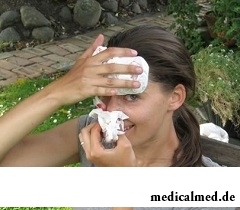 Independently it is difficult to distinguish internal bleeding. Its indirect sign after the happened injury, is the aggravation of symptoms of the person, blanching of integuments, the appeared cold sweat, blackout. Blood at the same time can be emitted with vomiting or with a stake, but it is not obligatory. If you noticed such signs, as first aid at internal bleeding it is necessary to undertake the following:
Independently it is difficult to distinguish internal bleeding. Its indirect sign after the happened injury, is the aggravation of symptoms of the person, blanching of integuments, the appeared cold sweat, blackout. Blood at the same time can be emitted with vomiting or with a stake, but it is not obligatory. If you noticed such signs, as first aid at internal bleeding it is necessary to undertake the following:
- At an injury of a breast to give to the person a semi-sitting position, at an injury of an abdominal cavity – lying;
- To provide inflow of fresh air;
- To put cold to a stomach or a thorax;
- To prohibit the victim to eat, drink, move and talk;
- To immediately take the person to hospital.
The last point is urgent not only for injuries of internals. In case of massive blood loss delivery of the victim in clinic for rendering the qualified medical assistance will be the main first-aid station at bleeding of any kind.
The 74-year-old resident of Australia James Harrison became blood donor about 1000 times. It has a rare blood group which antibodies help to survive the newborn with a severe form of anemia. Thus, the Australian saved about two million children.

People know that thermal sources have salutary force long ago. Treatment by natural waters is one and...
Section: Articles about health
From the failure of work of immune system which is shown in the form of an allergy, statistically, more than 40% of the population of the globe suffer. In most cases pathological reactions cause the substances which are contained in food stuffs, hair of animals, medicines...
Section: Articles about health
For most of the working people the problem of having a snack is particularly acute enough. Sooner or later there is a question: what can be eaten quickly between a breakfast and a lunch or a lunch and leaving from service so that to receive necessary power feed, but not to overload an organism with harmful components or excess calories? We bring to your attention the list of products which quite conform to these requirements....
Section: Articles about health
Life activity of one-celled fungi of the sort Candida is a proximate cause of development of candidiasis (milkwoman), it is related...
Section: Articles about health
For the city dweller the fitness is the most convenient sport. It is enough to acquire the subscription to the gym to get access to various apparatuses and an opportunity to train under the leadership of the experienced consultant. Many consider fitness on...
Section: Articles about health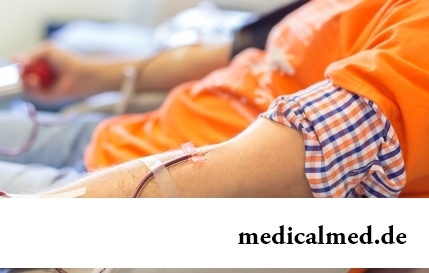
Transfusion of donor blood has almost century history. In spite of the fact that this procedure is quite usual for many people, process of blood donation is still surrounded with numerous myths. Today we aimed to discredit the most widespread of them....
Section: Articles about health
It seems, quite recently you brought the baby from maternity hospital, but time flew by, and here it is already going to join the first...
Section: Articles about health
Contrary to popular belief, the multiple sclerosis (MS) is not connected neither with sclerous changes of walls of vessels, nor with age forgetfulness and problems with concentration of attention. This disease has the autoimmune nature. Pathological process of a vyrazh...
Section: Articles about health
It is difficult to revaluate importance of kidneys for an organism. These bodies not only perform work on purification of blood of decomposition products and removal of excess liquid. They are responsible also for production of some hormones necessary for maintenance of a normality of a bone tissue, and also for a producing red blood cells – erythrocytes....
Section: Articles about health
Cystitis, or inflammation of a mucous membrane of a bladder, this very widespread disease, which, owing to some persons...
Section: Articles about health
What is in our understanding weeds? It plants which are considered to be suitable only for compost pits and feeding of animals. Meanwhile, among the weeds growing literally under legs it is possible to find the mass of the officinal herbs possessing invaluable Paul...
Section: Articles about health
The business lady, the become mother, it is necessary to solve an array of problems. But of them is main: how to combine the beloved child and work? What traps trap the working mother and how she needs to behave?...
Section: Slideshow
80% of women at least once to lives complained of discomfortable feelings to breasts, consolidations and nagrubaniye. These are mastopathy symptoms. Mas...
Section: Articles about health
The next flu epidemic leads to the next panic, from year to year we give in on these manipulations: professionally alarming voice of the announcer in news, reports with calculation of the died patients, an interview with people in white dressing gowns and advertizing of anti-influenza means ра...
Section: Articles about health
Deciding to get rid of an addiction, not all imagine what effects it is necessary to face. Process of refusal of smoking causes quite essential discomfort in most of people: differences of mood, a sleep disorder, fatigue, decrease in physical and intellectual activity and a number of other symptoms reducing quality of life. Abstinence can be strong: an essential part of attempts comes to an end leaving off smoking failure, and people are returned to the use of cigars...
Section: Articles about health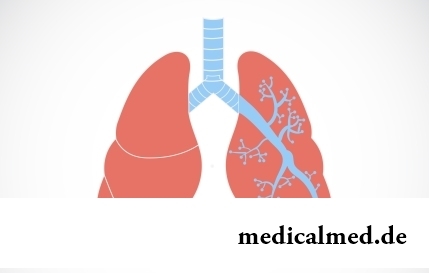
They say that to ensure health and longevity of people it is obliged. Really, at competent approach to these questions, we will pass...
Section: Articles about health
All know that self-treatment is dangerous. However absolutely it is almost impossible to do without it. Rate of modern life does not allow to handle each small trouble to the doctor and information on ways of independent rendering medical the help...
Section: Articles about health
Life does not indulge the modern woman special emotional comfort and carelessness. The fatigue, troubles at work, misunderstanding in a family and various illnesses immediately affect a condition of hair and skin. And there is a wish to look safe and attractive so! Substantially competently picked up diet can improve situation....
Section: Articles about health
Each woman has preferences in the field of use of those goods which help us to look good, feel се...
Section: Articles about health
Musicotherapy – a treatment method which caused and causes a set of a controversy concerning its efficiency. However the facts are relentless: during the numerous researches curative impact of music on an organism was scientifically confirmed. Since then in a number of the countries a method...
Section: Articles about health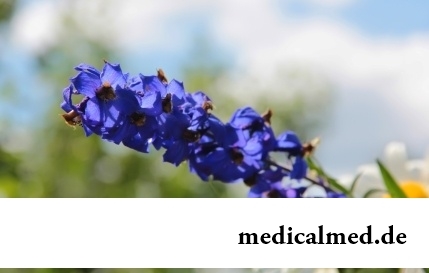
It is impossible to imagine human life in which there would be no plants. Practically in each apartment and any production room there are window plants, millions of people with pleasure are engaged in gardening and truck farming, many citizens spend free time on seasonal dachas. However we very seldom pay attention to those properties of our green pets who can make the neighbourhood with them unpleasant and even unsafe....
Section: Articles about health
Life of the modern child is extremely active and difficult. Information strain which is experienced by the school student and did not dream the pupil...
Section: Articles about health
The person, as well as all other beings living on our planet feels weather changing. It is the normal meteosensitivity which is not causing to healthy people of special troubles. Meteodependence, on the contrary, is morbid condition, характеризующимс...
Section: Articles about health
There comes the season of issues. Many Russians already dream of outdoor recreation, trips, beautiful seaside beaches. At this time there is no wish to think of problems with health and other unpleasant things, however there are subjects which require attention. In the summer repeatedly the risk increases to ache with some very dangerous illnesses, we also will talk about them today....
Section: Articles about health
It is known that the person for 80% consists of water which participates in all processes of an organism. The person loses liquid daily – in...
Section: Articles about health
One of the useful properties presented to the person by the nature is ability to feel fear. This ability is designed to signal about approach of a dangerous situation and to help to avoid in advance it to keep life. However if the fear is persuasive and not about...
Section: Articles about health
Producers of milk mixes for children assure: mixes are ideally balanced and adapted for needs of babies. If mother should raise artificially the kid owing to serious problems with health, to do nothing – it is necessary to feed with substitutes of milk. However pediatricians note that not seldom women without good reasons refuse feeding of the child a breast and pass to milk mixes. Common causes of such decision – the aspiration to leave quicker...
Section: Articles about health
